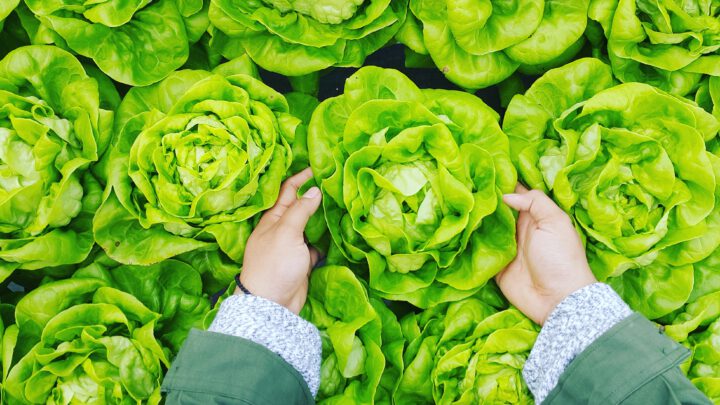When was the last time you felt the threat from hunger?
Hunger and starvation seem irrelevant to people living in the metropolitan cities. Although we don’t often see wheat and vegetable fields in our daily life, yet we always take it for granted that there will be fresh food available on the shelf in the supermarket.
Unfortunately, that is not the case for everyone. According to WHO’s data by July 2019, there are still more than 820 million people suffering from hunger globally.
The global population is predicted to reach 9.7 billion by 2050It’s estimated that global food production will need to increase by up to 70% in the next 30 years to feed everyone.
Agricultural Industrialisation vs COVID-19
To achieve the ‘zero-hunger’ SDG, we need to figure out a more efficient way to produce more food. However, not every country has sufficient arable land to produce various kinds of food. We need a better plan to leverage global resources to feed the whole human population.
The industrialisation of agricultural seems to be the answer. Similar to any kind of industrialisation process, it involves more refined division of labor. The whole process is broken down into small segments. Each party only needs to focus on what it is best at. The global supply chain then helps to distribute food to where it is needed.
However, COVID-19 pandemic was a wake-up call that this chain is not unbreakable. According to the Food and Agriculture Organization (FAO) of the United Nations, border closures, quarantines and disruptions to supply chains are limiting some people’s access to food.
Even for free port like Singapore and Hong Kong, people had sensed panic over food shortage and started panic buying and food hoarding.
Indoor Farming: Closer, Greener, Fresher
And we’re not just talking about grains. To live a heathy life, we also need vegetables, fruits, meats, etc. However, even if you may stock up wheat or rice for years, you can’t do that with fresh food.
Is there another way to secure the supply of vegetables for cities that do not have enough arable land or spaces? Can we farm in the urban jungles?
Indoor Farming might have provided us with some hints.
Indoor vertical farming system can be hosted in shipping containers, tunnels, abandoned mine shafts and any ordinary building in a city. So don’t be too surprised if later you find some 3-dimensional green field right next door to your office or home.

source: agrify.com
While rising temperatures and more frequent droughts caused by global warming are making traditional farming increasingly unpredictable, indoor farming can achieve all-season farming with better managed growing conditions.
For example, one of the world’s largest vertical plane aeroponic farms. Their production requires 95% less water and 99% less land, and all products are grown without pesticides, herbicides or GMOs.
As a result, consumers can enjoy fresher and healthier ready-to-eat vegetables with more favourable price all year round.
Technology: Money for value
To manage the growing condition and producing more reliable yields, technology is the key competence for the vertical farming industry. The indoor farming technology market was valued at $23.75 billion in 2016 and is projected to reach $40.25 billion by 2022.
Some farm adopts space technology in indoor farming. Aeroponics technology is a plant-cultivation technique in which the roots of each plant are suspended in the air where the nutrient laden mist is delivered directly to them. Aeroponic growing system was first conceptualised by NASA as a possible means of growing food in space.
Some other indoor farms like Square Roots uses artificial intelligence (AI) to ensure the environment is optimal for each specific kind of plant, including 7×24 temperature conditioning, and optimization of CO2 supply. Another example is Plenty which eliminates the need for pesticides with LED lights, which are synced with the crop’s growth.
We see vertical farming as a strong and necessary complement to traditional farming, as it provides green variables to grains that rely on traditional farming. On the other hand, the technology used in vertical farming may also provide reference to traditional farming to help reduce the risk of exposure to harsh climate conditions.
From an ESG investment point of view, vertical farming catches our attention not only because it helps adapt to a warming planet, but also its potential to help slow down climate change by being more sustainable and resource-efficient.
A vertical farm combined with renewable energy would work extremely well, as it does not require a continuous baseload of energy and can cope with intermittency.
We truly believe that with the right investment and engagement, vertical farming can eventually become the food production method of choice for future generations.
Reference list
FAO – impact on food and agriculture
Forbes – Is The Future Of Farming Indoors?
.
.


The Future of Farming – Avantfaire Investment Management Limited
[…] Earlier in March we’ve discussed how COVID-19 pandemic has broken the global food supply chain and forced people to pay more attention to agriculture, especially local farming and indoor farming. […]
Agriculture Deep Dive – Avantfaire Investment Management Limited
[…] we make it by changing the way we eat or the way we produce what we eat? We have discussed about vertical farming and some trends in China before. Today, we would like to take an agriculture deep dive and explore […]